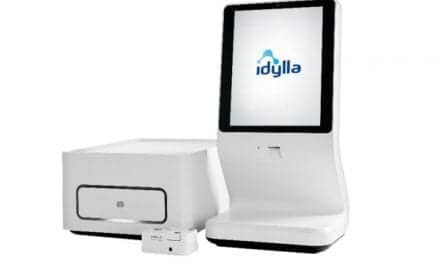T2 Biosystems, Lexington, Mass, has announced publication of pivotal trial results providing decisive evidence for the first direct-from-blood, non-culture test cleared by FDA for the diagnosis of bloodstream infections by multiple bacteria.1
The T2Bacteria panel is the first FDA-cleared test to identify sepsis-causing bacteria directly from whole blood without the wait for blood culture, which is the current standard of care for diagnosing bloodstream infections but takes 1 to 5 days, or longer, to produce results. The T2Bacteria panel delivers results in 3 to 5 hours for the antibiotic-resistant ‘ESKAPE’ bacteria, Enterococcus faecium, Staphylococcus aureus, Klebsiella pneumoniae, Acinetobacter baumannii, Pseudomonas aeruginosa, and Enterobacter spp.
“With a blood culture, it typically takes days to cultivate organisms to learn if a patient has bacteremia and, if so, what bacteria is causing the infection. Additionally, blood cultures are not always sensitive enough to pick up the presence of bacteria in the bloodstream, such as when the patient has already been started on antibiotics,” explains Minh-Hong Nguyen, MD, a professor of medicine at the University of Pittsburgh and lead author of the study. “There are well known limitations with relying solely on blood cultures. Technology that can deliver pathogen results in a matter of hours from initial blood draw—a capability which is unlike any other FDA-cleared device in the market today—can allow clinicians to approach initial clinical bloodstream infection treatment in a more informed way.”
The pivotal study data exhibited the advantages that the T2Bacteria panel can provide in diagnosing bloodstream infections. Key findings from the study included:
- Blood cultures took between 32 and 111 hours to identify pathogens whereas the T2Bacteria panel took 3.6 to 7.7 hours to do so.
- In 78% of probable or possible bloodstream infections, subjects had blood culture-negative/T2Bacteria positive results despite treatment with active antibiotics.
- At 24 hours after blood draw, 20% of patients with blood culture-positive/T2bacteria-positive results were still not receiving effective therapy.
- The T2Bacteria panel had a 99.7% negative predictive value.
- The T2Bacteria panel had overall sensitivity of 89.7% per subject and per assay.
- The T2Bacteria panel had overall specificity of 89.5% per subject and 97.8% per assay.
“This study clearly demonstrates that there are shortcomings with the sensitivity and speed of blood culture results, and that the T2Bacteria panel can shorten the time to appropriate antibiotic treatment in patients—a huge step in the right direction for improving clinical outcomes,” says Nguyen. “Timely administration of appropriate treatment might also help reduce hospital costs, such as by reducing length of stay, another added benefit to this technology.
“Now that we have this information, it’s crucial for clinicians to come together to understand how to incorporate this technology into rational patient management and antibiotic stewardship strategies,” Nguyen adds.
The T2Bacteria panel is part of a suite of products that includes the T2Candida panel—the first direct-from-blood detection panel that provides same-day results for the most clinically relevant fungi. Both panels run on the company’s T2Dx instrument, a fully automated, walkaway, clinical multiplex benchtop diagnostic system capable of running tests directly from whole blood.
For further information, visit T2 Biosystems.
Reference
- Nguyen MH, Clancy CJ, Pasculle AW, et al. Performance of the T2Bacteria panel for diagnosing bloodstream infections: a diagnostic accuracy study. Ann Intern Med. 2019;170(12):845–852; doi: 10.7326/m18-2772.
Featured image:
digitally-colorized, scanning electron microscopic (SEM) image, depicts four magenta-colored, spherical, methicillin-resistant, Staphylococcus aureus (MRSA) bacteria. CDC Public Health Image Library, ID 18167.





